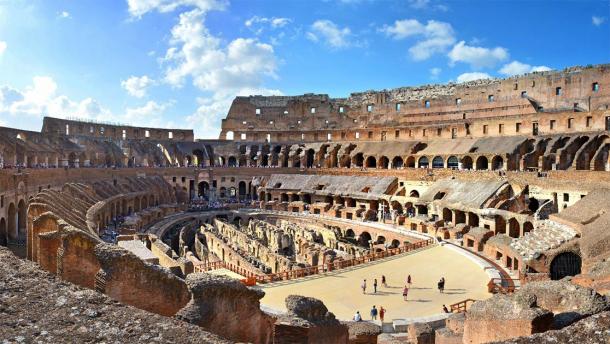The Flavian Amphitheater, better known as “The Colosseum,” is the world-famous ancient structure located in the center of the city of Rome, Italy, and it represents the largest Roman amphitheater ever built. At full capacity the venue could hold up to 80,000 spectators, and it was here at this 2,000-year-old super-structure that on Monday night a security guard caught an Irish tourist carving his initials onto one of the massive stone pillars.
A spokesperson for Italy’s Carabinieri police told CNN that the Colosseum’s security team identified the tourist as a 32-year-old Irish man whose name has yet to be made public. The vandal used “a metal point” to carve his initials about 2 inches high onto a pillar on the Colosseum‘s first floor, and for this act, the Carabinieri police told CNN that the Irish man has been accused of “damaging a historical and artistic landmark,” which they say could see the vandal fined up to $2,400 (€2,065).
$2,400 (€2,065) is nothing for such a display of narcissism many of you will be thinking, but you can be happy knowing that the accused might be banged up in a prison cell for a year, where he would be, somewhat ironically, surrounded by the carved initials of others who unashamedly broke Italian heritage and other laws.

There were once plenty of cells at the Colosseum filled with prisoners awaiting their fate. ( Petair / Adobe Stock)
The Colosseum: An Ancient Idiot Magnet
The Colosseum is a protected UNESCO World Heritage Site that only reopened to tourists on June 1 after being temporarily closed for three months due to the coronavirus pandemic. Only this morning Insider journalists sent questions about the man’s willful vandalism to representatives for the Colosseum Archaeological Park , and Italy’s Ministry of Culture and Tourism, but at the time of writing they have not responded to requests for comment. However, archaeologist Federica Rinaldi told CNN that “Carving one’s initials, in addition to being a crime, seems to be a gesture of those who want to appropriate the monument,” and she suggested the arrested tourist should have “taken a selfie!” at the Roman amphitheater . It wouldn’t surprise me if that was his ingenious master plan: 1) carve initials on Colosseum, 2) Take selfie including those initials to show how awesome I am.

Wouldn’t something like this be cool enough? ( Parilov / Adobe Stock)
According to the Associated Press a similar crime was committed at the Colosseum in 2017 when a tour guide spotted an Ecuadorian visitor carving the names of his family and the year 2017 on walls inside the world famous ancient monument. What’s more, in 2015, the Guardian reported on the arrest of two Californians who carved their initials and posted selfies with their work online, and in 2015 they reported on a Russian tourist being fined $23,000 (€20,000) and slammed up for four months in prison for carving his initials into the Colosseum.
Is It Time For Draconian Protection Methods?
Little over six weeks ago I wrote an Ancient Origins news feature about a 50-year-old Austrian tourist being caught on CCTV snapping two toes off a 200-year-old Antonio Canova sculpture-model at the Gypsotheca Antonio Canova Museum in Possagno, Italy, and the security camera footage showed the man wandering off like nothing had happened. Staff at the Italian museum were rightfully enraged at the man ’s sheer ignorance and tweeted: “An Austrian tourist sat on the sculpture of Paolina Bonaparte causing two toes to break, then quickly moving away from the museum, without denouncing the fact.”
All of the acts of archaeological vandalism mentioned in this article occurred because tourists were allowed to touch, and interact with archaeology, so maybe the time has come to really protect cultural treasures with creative solutions, like for example, “dynamic-interpretation”. This was suggested way back in 1999 in an NPS History paper entitled Preventing Cultural Resources Destruction Taking Action through Interpretation which said the best way to avoid damage to archaeological sites is “keeping them (us) back”.
Touching Is So 2019
The paper listed many innovative methods of using creative parking, human-barriers and informative interpretation panels to both inform tourists and keep them away from the facias of the crumbling architectural marvels, and in today’s world of Smartphone technology and augmented reality apps there really is no need whatsoever for tourists to touch archaeology, just like nobody needs to rub the Mona Lisa to become haunted by her.
It does seem regretful that the majority will be penned out because of the few. Perhaps as a short term educational drive, and with the practice of offenders being forced to fight gladiators now being frowned upon, I’d ring historic monuments with electric fences, with no warning signs. I’d then have a webpage live-streaming the most hilarious footage of idiots getting shocked into discipline, and as draconian as this solution might come across, is it any less heinous than the narcissistically inspired crime of carving one’s own initials into an otherwise magnificent structure?
Top image: Representative selfie taken at the Colosseum , Rome Source: Davide Angelini / Adobe Stock
By Ashley Cowie
Related posts:
Views: 0
 RSS Feed
RSS Feed

















 September 30th, 2020
September 30th, 2020  Awake Goy
Awake Goy  Posted in
Posted in  Tags:
Tags: 
















